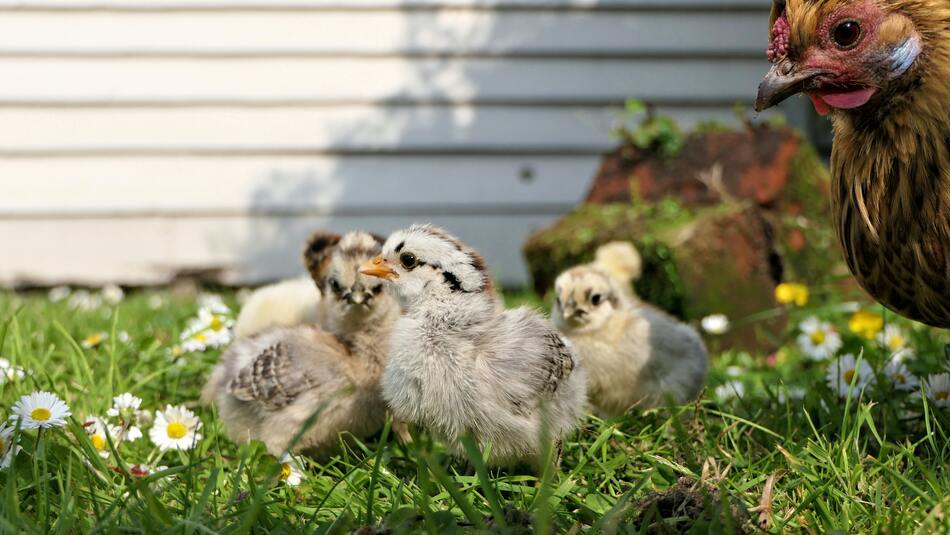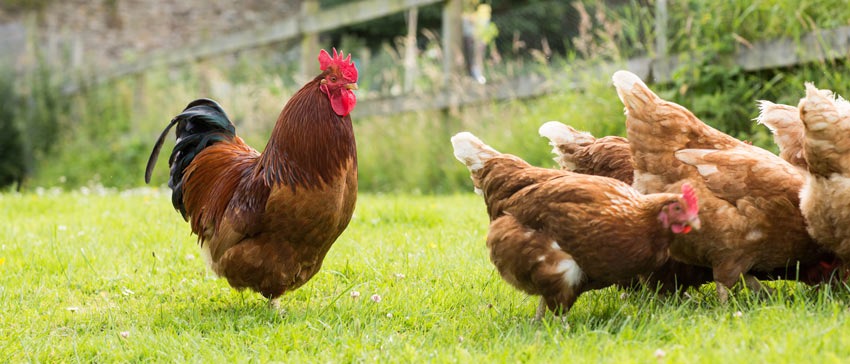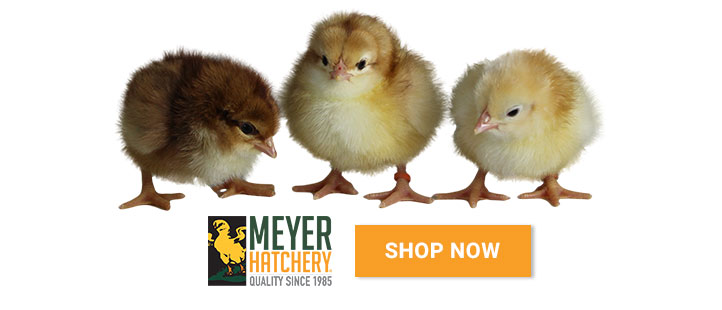Choosing adult chickens or baby chicks?
You can buy chickens when they are still chicks, or you can choose ‘point of lay’ hens (also known as started pullets). These are ready-to-go birds that are about to begin laying eggs, and they offer the easiest entry into the wonderful world of chicken keeping.
If you choose to buy chicks or hatch fertilized eggs laid by your own hens, you will have to care for the young birds for the five months before they start laying. They are extremely cute but delicate little things, and easy prey for cats, rats and other creatures that wouldn’t attempt to attack a full sized hen. You will also need to keep them warm, which means investing in special equipment.

So, if you are simply keeping chickens for fresh eggs, you should start with adult birds rather than chicks.
Why buying point-of-lay hens?
This is the entry point for most people who are new to keeping chickens. By checking availability in your local area, you will be able to source birds close to home. The advantages of choosing these older birds pretty much outweigh all other options, and the only reason you would opt for buying or hatching chicks is if you want to look after small birds. For many people, this is a very rewarding activity, but for someone who just wants to look after laying hens, started pullets are the way forward.
Why keeping ex-barn hens?
Another great way to stock your coop is with rescued chickens. Intensively reared hens kept in barns are judged to be past their prime after a year and a half, even though they still have a good 18 months of laying ahead of them. For the majority, this is the end of the road. However, charities such as the Animal Place in California relocate these hens and give them new homes.
All ex-barn hens have great charm and personality. They tend to look rather bedraggled and sad when first rescued from their imprisonment, but with a bit of TLC they will blossom as impressively as the Ugly Duckling!
What do I need to know about buying chicks?
You need to be sure that you buy baby hens and not cockerels. There are no external clues as to what sex a chick is, and any stock sold sight unseen (or ‘straight run’) will be a 50/50 mix of male and female birds. You need the chickens to be sexed to ensure you get hens. If this is not possible, wait for started pullets to become available.
Chicks need special accommodation for the first few weeks, and they can’t simply be kept in a standard coop and run. You can buy brooder boxes to keep them, or you can improvise one using a cardboard box or plastic bin with holes in the side. The important thing is to keep the birds warm and protect them from drafts while ensuring good ventilation.
After transferring your chicks to their brooder, pay close attention to how they behave. If they’re crowded together directly under or adjacent to the heat source, they’re cold. Lower the heat source closer to them or add another. If, on the other hand, they shy away from it, they’re too hot. In this case, the heater or bulb will need to be moved further away.
What do I need to know about chicken brooders?
You will need to provide 6 square inches (39 square cm) per chick in the brooder. Once they are five weeks old they can be moved to a coop and run, where they will need at least two square feet (0.19 square meters) per bird. You can buy brooder boxes to keep chicks in, or can make one yourself using a cardboard box or plastic bin with holes in the side. The important thing is to keep the birds warm and protect them from drafts, while ensuring good ventilation.
The chicks need to be kept in a temperature of 35C (95F) in their first week. The heat should be reduced slightly each week until you’ve reached room temperature. A heater designed for coops and aviaries is the best option. A red heat bulb is another option (not a white one – these produce glare that keeps chicks awake at night and tends to make them irritable and prone to pecking). Standard light bulbs will not do the job.
Very young chicks will need to have their water changed at least twice a day, as they have the ability of turning all liquids to messy soups within a few hours! They also need their bedding changed at least once a week. A chicken wire covering for the top of the brooder is recommended, too. Chicks can easily ‘fly the nest’ if the sides of the brooder are less than 1’5″ high.
Chicks can spend a little time outdoors when they’ve reached two weeks. A large wire cage or some other type of portable enclosure can be placed outside for a few hours a day – but only if it’s at least 18C (65F) and not too windy, and dry. The birds will need food, water and shade, and shouldn’t be left alone for very long. Predators are everywhere when you’re a small chick!
Once they’ve reached four to five weeks, the chicks can be moved permanently into the outdoor chicken run.
Do I want to breed my own chickens?
Another way of keeping chickens is to keep the flock refreshed by hatching eggs from their own chickens. The easiest way of raising chickens is to let nature take its course. All you have to do is provide a nest box for a broody hen. She will provide the right conditions for hatching eggs (although she will not be able to cope with more than a dozen at a time, or fewer with smaller breeds), warming and turning them as necessary. An incubator is the alternative hatching method.
A cockerel will do everything in his power to tread the hens in his flock and fertilize the eggs. If a chicken is broody, she will then sit on the eggs for 21 days (the incubation period), and with a bit of luck these eggs will then hatch.

Rearing chicks is a great hobby, but you need to be dedicated to the job. If all you want is fresh eggs and a flock of healthy and happy adult chickens wait for point-of-lay birds to become available. Also, contacting a local hatchery for more information is always a good move.
This entry was posted in Chickens


2 replies on “Choosing adult chickens or baby chicks?”
I would like to buy some point of lay hens. Easter eggers
would like to buy 6 white Legger pullets